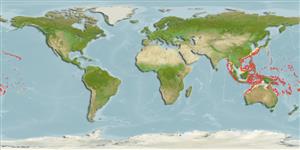Common names from other countries
>
Eupercaria/misc (Various families in series Eupercaria) >
Lutjanidae (Snappers) > Etelinae
Etymology: Pristipomoides: Greek, pristis = saw + Greek, poma, -atos = cover, operculum + Greek, oides = similar to (Ref. 45335).
More on authors: Jordan, Evermann & Tanaka.
Environment: milieu / climate zone / depth range / distribution range
Ekologi
marina bentopelagisk; djupintervall 90 - 360 m (Ref. 9821), usually 181 - 270 m (Ref. 58302). Deep-water; 35°N - 25°S, 89°E - 150°W (Ref. 55)
Indo-Pacific: Reunion (Ref. 33390) to Hawaii and Rapa, north to Japan, south to Australia and New Caledonia.
Size / Vikt / Age
Maturity: Lm ? range ? - ? cm
Max length : 45.0 cm TL hane/ej könsbestämd; (Ref. 30874); common length : 25.0 cm SL hane/ej könsbestämd; (Ref. 9821)
Taggstrålar i ryggfenan (totalt) : 10; Mjukstrålar i ryggfenan (totalt) : 11; Taggstrålar i analfenan: 3; Mjukstrålar i analfenan: 8. Interorbital space flat. Dorsal and anal fins without scales, their last soft rays extended in short filaments. Pectoral fins long, reaching level of anus. Scale rows on back parallel to lateral line. Body purplish or brownish violet; sides with numerous yellow spots or faint yellow, chevron-shaped bands; the upper lobe of the caudal fin yellow; dorsal fin yellowish to yellowish-brownish.
Adults are found over rocky bottoms; off Guam, caught most abundantly from 180 to 270 m (Ref. 55). They feed on fishes and salps. Marketed fresh (Ref. 55).
Life cycle and mating behavior
Maturities | Reproduktion | Spawnings | Egg(s) | Fecundities | Larver
Allen, G.R., 1985. FAO Species Catalogue. Vol. 6. Snappers of the world. An annotated and illustrated catalogue of lutjanid species known to date. FAO Fish. Synop. 125(6):208 p. Rome: FAO. (Ref. 55)
IUCN Red List Status (Ref. 130435)
CITES (Ref. 128078)
Not Evaluated
Threat to humans
Harmless
Human uses
Fiskeri: kommersiell; sportfisk: ja
Verktyg
Special reports
Download XML
Internet-källor
Estimates based on models
Preferred temperature (Ref.
115969): 12.2 - 22.9, mean 14.9 (based on 151 cells).
Phylogenetic diversity index (Ref.
82804): PD
50 = 0.5005 [Uniqueness, from 0.5 = low to 2.0 = high].
Bayesian length-weight: a=0.01318 (0.00757 - 0.02297), b=2.98 (2.83 - 3.13), in cm Total Length, based on LWR estimates for this species & Genus-body shape (Ref.
93245).
Trofisk nivå (Ref.
69278): 3.9 ±0.0 se; based on diet studies.
Resiliens (Ref.
120179): Mellan, lägsta populationsfördubblingstid 1,4-4,4 år (K=0.3).
Fishing Vulnerability (Ref.
59153): Low to moderate vulnerability (33 of 100).
